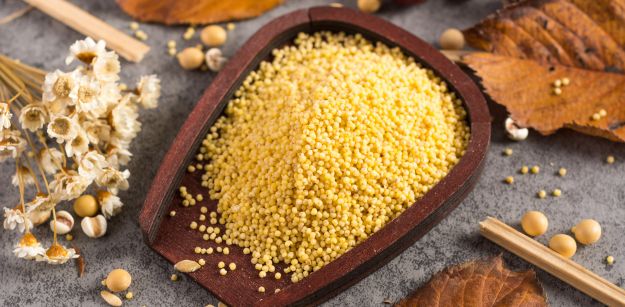Millets have a lot of health benefits when consumed on a daily basis. You can also use it in your diet for diabetes. Eating millet on a daily basis is also a good choice to prevent the symptoms of diabetes.
By including a healthy meal plan and balanced diet you can maintain your blood sugar level and keep your weight on track. During the current busy life, maintaining a healthy lifestyle is important. Controlling blood sugar levels is important for diabetes. In this blog, we will discuss the importance of millet for diabetes and how to include millet based food products in your diet.

Is It Safe to Eat Millet for People Suffering from Diabetes
Yes, it is safe to include millet in the diets of people suffering from diabetes.
Millets are a rich source of protein and smooth insulin sensitivity; these make them safe to consume for diabetes patients. Carbohydrates in the body are converted into energy by the insulin present in the hormone. Occasional consumption of the millet won’t create a larger impact, but you must consume it regularly if you want to see a better result. These are some reasons that make it safe to consume for a person suffering from diabetes.
How Consuming Millet Regularly Be Beneficial for Diabetes
There are studies that show consuming millet has a positive effect on people suffering from diabetes. One such study was done on people suffering from type 2 diabetes. They have tested the effect of foxtail millet on diabetes. It was found that switching from rice to millet can help to lower the blood sugar level after meals.
Millets contain high fiber content and antioxidants. This results in a reduction in insulin spikes and improves the digestion process. Also, millets have a good amount of carbohydrates which helps in weight loss and lower the amount of blood sugar spikes.
Millets have a low glycemic index; thus, the body takes a longer period to metabolize and break down millets. It is absorbed by the bloodstream at a much slower rate and needs less insulin. According to research published in the Journal of Food and nutritional disorders, millets may be helpful in reducing fasting and after-meal blood sugar levels for diabetes patients as well as healthy individuals.
What Is Glycemic Index (GI)
In easy language, glycemic index (GI) is a ranking of foods based on the carb’s digestion and the effect on blood glucose levels. The GI is used to measure how rapidly the carbohydrates present in foods are converted into glucose and how a particular food increases the blood sugar level.
Blood sugar responds differently to carbohydrates present in different foods. This depends on the types of carbs consumed. Glycemic index of food helps to keep blood sugar levels under control by fine-tuning the carb count.
Glycemic Index of Millets
As discussed earlier, the blood sugar level can spike immediately if you consume food with high GI. On the other hand, foods with low GI like millet digest foods slowly and release a steady glucose. Thus low-GI foods avoid sudden spikes in blood sugar levels.
The GI level of Kudo and barnyard millets is less than 55. While the GI level of foxtail, little, finger, pearl millets, and jowar are between 55 to 70.
Thus, millet has low to moderate GI levels. Consumption of millet can prevent and manage type 2 diabetes and lessen the related symptoms. The following points need to be considered for diabetes patients.
Include a food diet that has a low or medium glycemic index. Replace dairy food products that are high in carbohydrates with low or moderate GI foods to maintain the blood sugar level. Select the food with a low GI level and find ways to include it in your daily diet.
You can include millet in your daily diet in different ways. You can take ragi dosa with chutney for breakfast. You can also take foxtail millet with sambar and vegetables. You can take the advice of a dietician to include low-GI food in your diet.

How to Include Millets in Your Daily Diet
You can include millet in your daily diet to gain various health benefits. You can try following simple ways to include it in your meals.
- You can consume it in the form of porridge for breakfast.
- Replace rice, wheat, and rava with millet in the meal.
- You can consume it with millet grilled vegetables or fresh salad making it more nutritious and healthier.
- Millet dosa can be taken with different chutney to make it more delicious
- Can replace maida with millet noodles and pasta, which are easily available online.
What Exact Amount of Millet Should Be Consumed?
Millets are a good source of insoluble fiber which can add bulk to the stools. There are a lot of factors that lead to the consumption of millet including individual sugar levels, gut health, and calories required. You can consult a dietician to make a customized dieting plan best suitable for your needs.
What are the Best Millets for Diabetes
Millets with low GI levels are best for diabetes, following millets can help with diabetes.
Foxtail Millets for Diabetes – A study conducted on type 2 diabetes people found that including foxtail millets in the diet can help to lower blood sugar levels, cholesterol, and triglycerides. When compared with rice, millet consumption reduces blood sugar levels after consumption.
Finger Millet for Diabetes – Consumption of finger millets increases the blood sugar level slowly and gradually. Finger millet is high in fiber and low GI, which controls blood sugar levels and lower cholesterol. These factors help to control diabetes.
Barnyard Millets for Diabetes – A study shows a positive impact of barnyard millet on blood glucose and serum lipid level for the diabetic.
Finger Millet for Diabetes – Finger millet is antidiabetic and antioxidant due to polyphenols found in finger millet. Finger millet has high fiber content which reduces the glycemic response.
Pearl Millets for Diabetes – Pearl millets can help to improve insulin sensitivity and reduce the level of triglycerides. It has high fiber content which helps to control diabetes. It is digested at a slower pace and releases glucose into the blood at a slower rate. This helps to maintain the blood sugar level in the diabetic patient for a longer duration.
Millet has a lot of health benefits. It can help to control various health-related issues including diabetes. There are various ways you can include millet in your diet. Millets are a healthier option as compared with other food grains. You can start consuming millet in your daily diet for various health benefits.